Bitcoin hits record high over $124k on rate cut bets, corporate treasury cheer
Introduction & Market Context
Viasat Inc (NASDAQ:VSAT) presented its Q1 FY2026 earnings results on August 5, 2025, revealing modest overall growth with standout performance in its Defense & Advanced Technologies segment. The global satellite communications provider reported a 4% year-over-year revenue increase to $1.17 billion, while Adjusted EBITDA grew slightly by 1% to $408 million. Following the presentation, Viasat’s stock rose 5.08% during regular trading hours, with an additional 0.44% gain in after-market trading.
The company, which operates 23 satellites and has a presence in 76 countries, continues to execute its multi-orbit strategy while focusing on improved cash flow generation. This quarter’s results build upon momentum seen in the previous quarter, where Viasat exceeded revenue expectations with $1.15 billion against a forecast of $1.13 billion.
Quarterly Performance Highlights
Viasat reported solid financial results for Q1 FY2026, with notable improvements in cash flow metrics. Revenue reached $1,171 million, up from $1,126 million in Q1 FY2025, while Adjusted EBITDA slightly increased to $408 million from $404 million in the same period last year.
As shown in the following financial summary from the presentation:
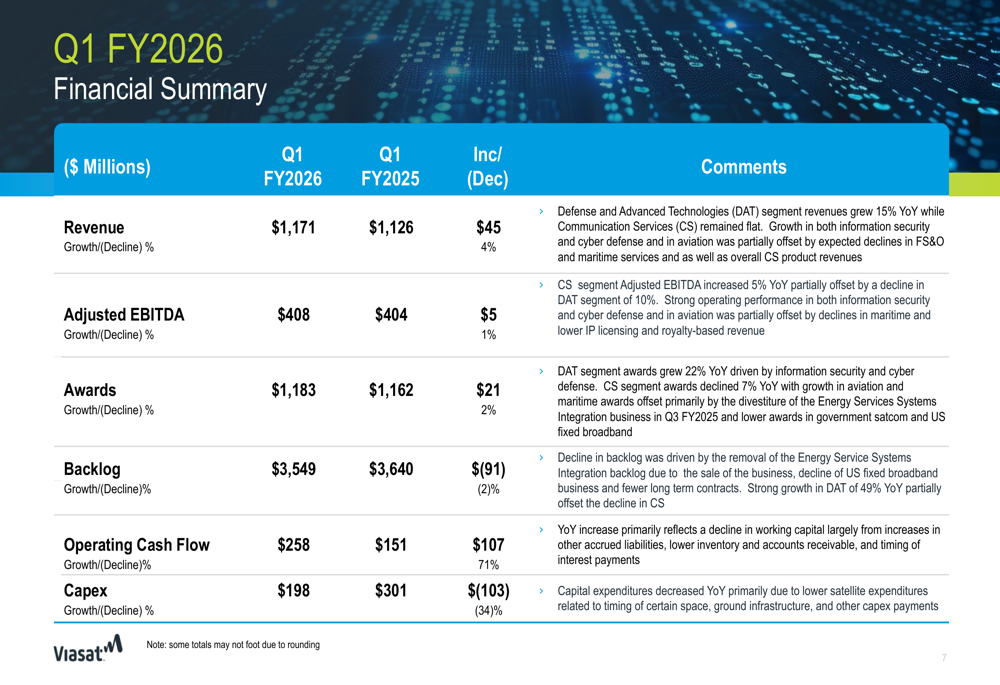
The company demonstrated significant improvement in operating cash flow, which increased 71% year-over-year to $258 million, while capital expenditures decreased 34% to $198 million. This focus on financial discipline appears to be a key strategic priority as Viasat continues to manage its substantial debt load.
Awards for the quarter totaled $1,183 million, a slight increase from $1,162 million in Q1 FY2025, while backlog decreased modestly to $3,549 million from $3,640 million. The company highlighted strong momentum across its business segments, particularly in Defense & Advanced Technologies, aviation, and maritime services.
Segment Performance Analysis
Viasat’s Defense & Advanced Technologies (DAT) segment emerged as the standout performer in Q1 FY2026, with revenue growing 15% year-over-year. This growth was primarily driven by increases in information security, cyber defense, and space and mission systems. The segment’s backlog increased impressively to $1.1 billion, up 49% year-over-year and 8% sequentially, indicating strong future revenue potential.
The detailed performance of the DAT segment is illustrated in the following slide:
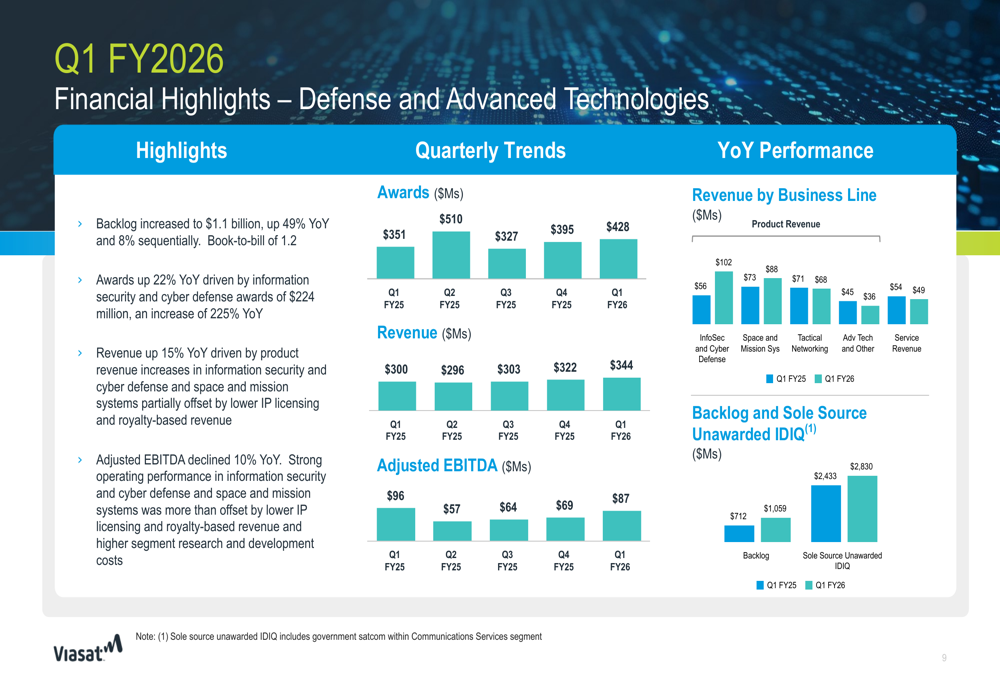
Meanwhile, the Communication Services segment showed mixed results. Aviation service revenues increased 14% year-over-year and government satcom grew 4%, but these gains were partially offset by declines in fixed services and maritime services. Product revenues in this segment declined 17% year-over-year, primarily due to the divestiture of the Energy Services Systems Integration business.
The Communication Services segment performance breakdown reveals these trends:
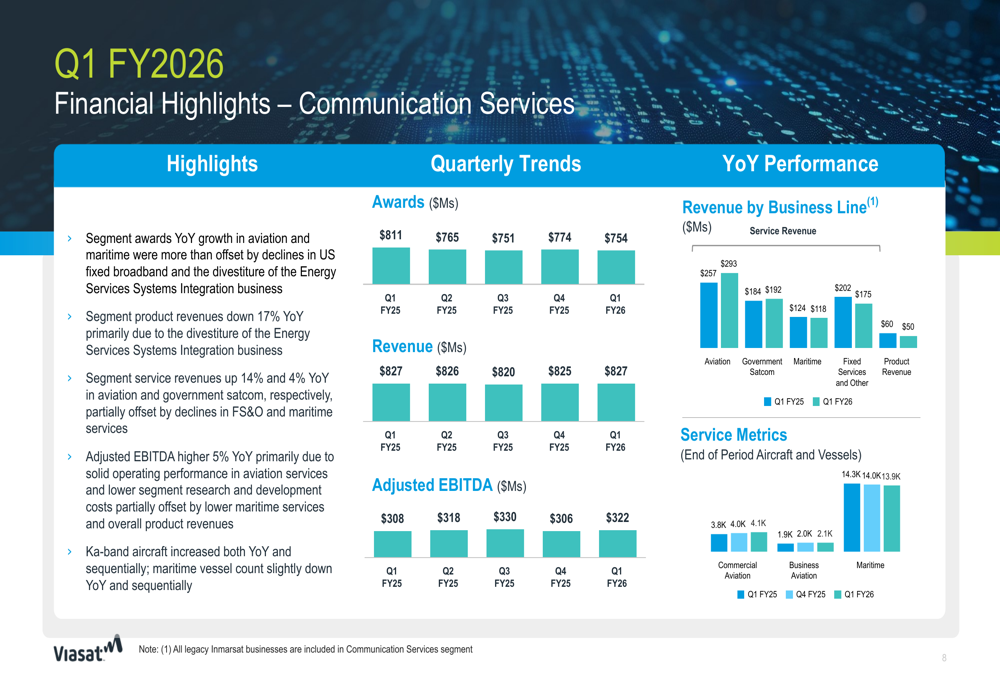
The company highlighted its advancement in multi-orbit offerings, securing selection by LATAM Group and an agreement with Mitsui O.S.K Lines, which should support future growth in the aviation and maritime sectors.
Satellite Development Strategy
Viasat’s long-term growth strategy centers on its extensive satellite development roadmap, which includes multiple satellites in various stages of development. The company’s current fleet of 23 operational satellites will be expanded with eight more under development, including the ViaSat-3 series, GX-7/8/9, GX-10A/B, and Inmarsat-8.
The comprehensive satellite roadmap illustrates the company’s strategic vision:
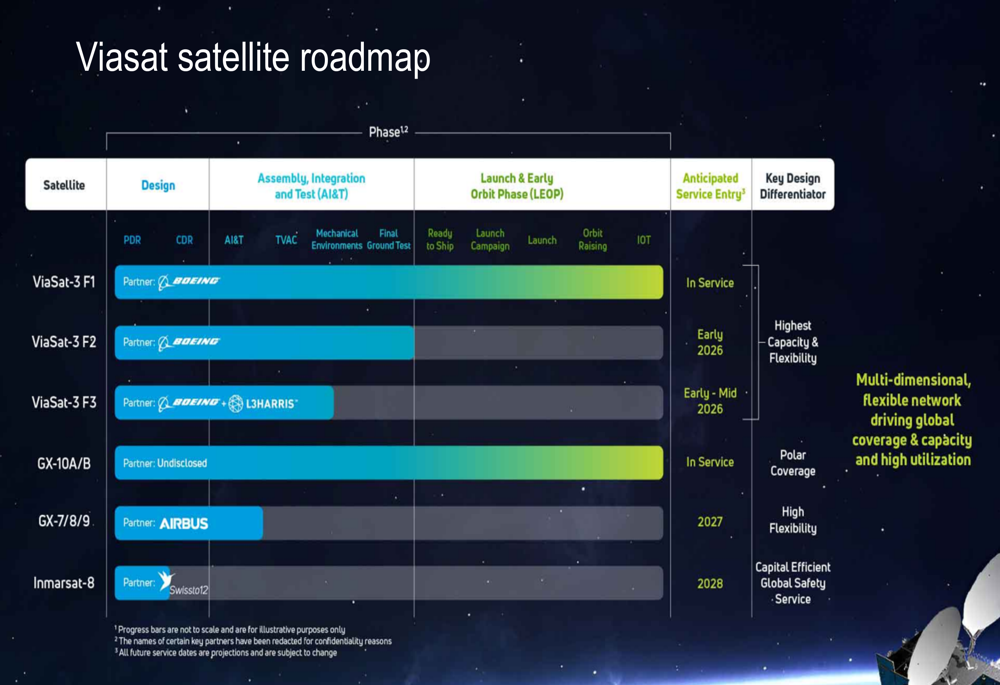
This satellite development pipeline is designed to enhance Viasat’s global coverage and capacity, with different satellites offering specialized capabilities such as polar coverage, high flexibility, and capital-efficient global safety services. The company’s ability to execute this ambitious roadmap while managing its financial position will be crucial for long-term success.
The geographical distribution and technical capabilities of Viasat’s current and planned satellite fleet demonstrate its comprehensive approach to global connectivity:
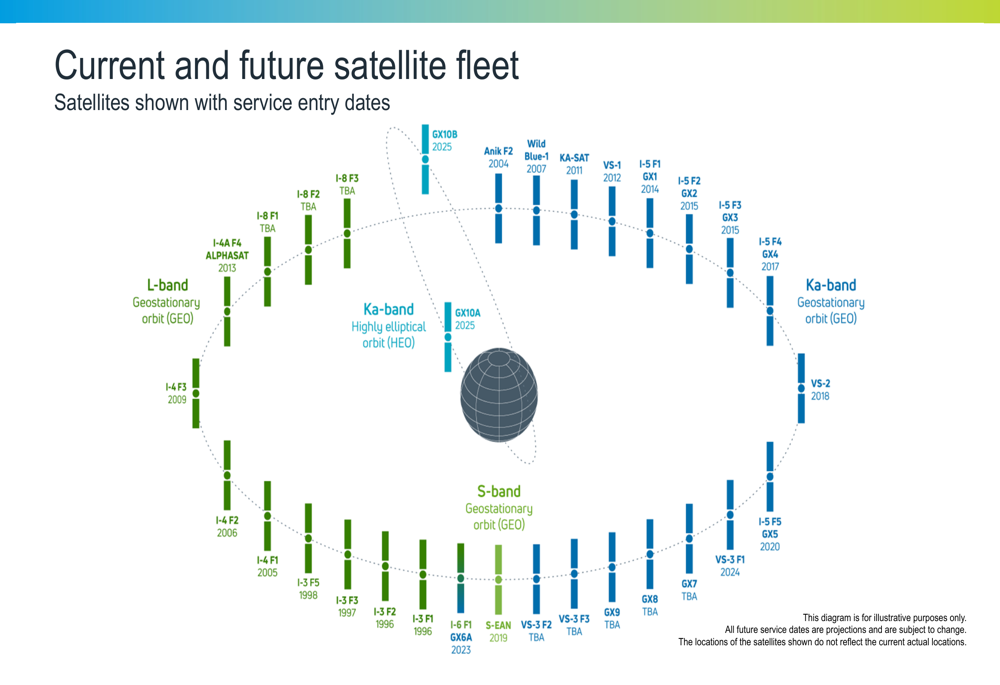
Financial Position and Outlook
Viasat continues to manage a substantial debt position, with gross outstanding debt of $6,742 million as of Q1 FY2026, down from $7,456 million in Q1 FY2025. Net debt stood at $5,564 million, slightly reduced from $5,645 million a year earlier. Total (EPA:TTEF) liquidity decreased to $2,323 million from $2,950 million in the comparable period.
The company’s debt maturity profile and composition are shown in the following slide:
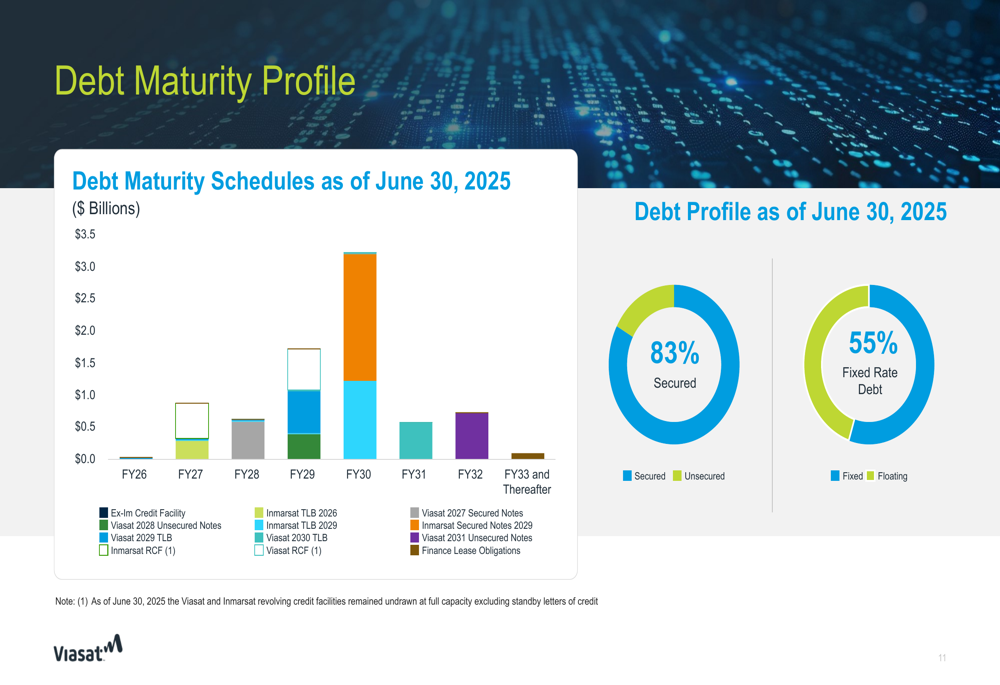
Looking ahead, Viasat updated its FY2026 guidance, maintaining projections for low single-digit total revenue growth and flat Adjusted EBITDA. The company revised its capital expenditure forecast downward from approximately $1.3 billion to $1.2 billion, suggesting increased focus on capital efficiency. Management expects to achieve positive free cash flow in the second half of FY2026 and anticipates a modest increase in net debt relative to LTM Adjusted EBITDA.
The updated guidance is summarized in this slide:
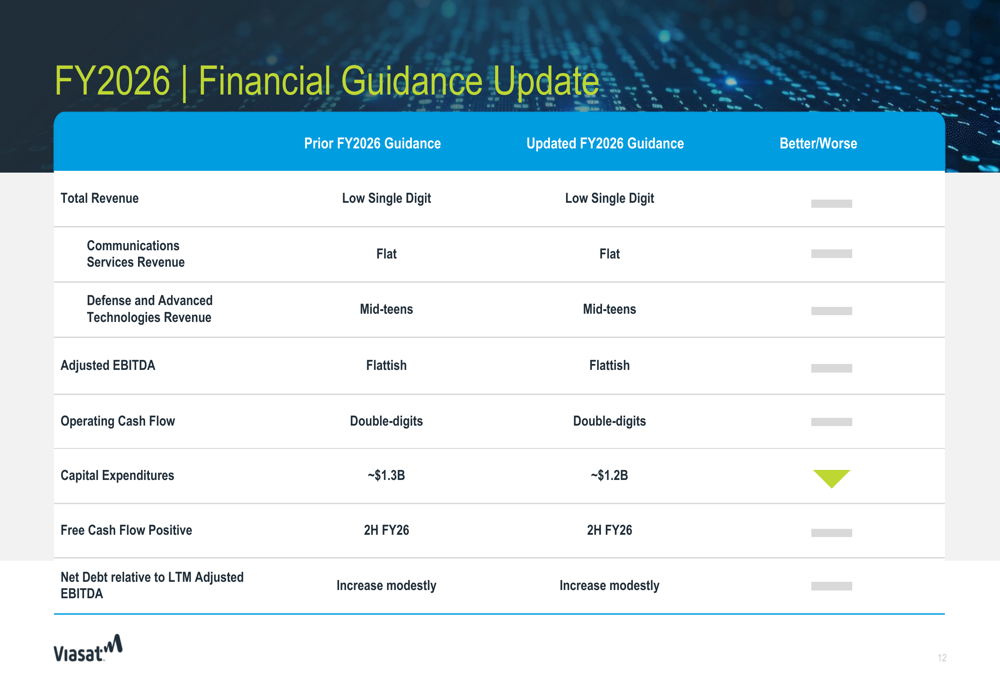
Viasat’s focus on operational efficiency and cash flow generation, combined with its strategic investments in satellite technology, positions the company to address both near-term financial challenges and long-term growth opportunities. However, the substantial debt burden remains a key consideration for investors evaluating the company’s financial health and future prospects.
Full presentation:
This article was generated with the support of AI and reviewed by an editor. For more information see our T&C.
